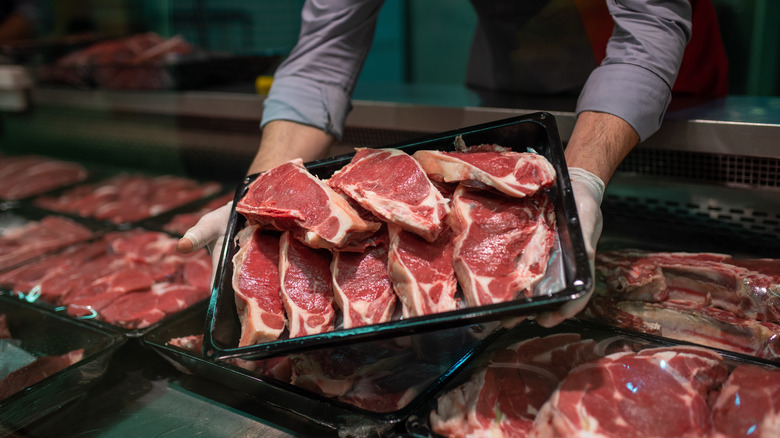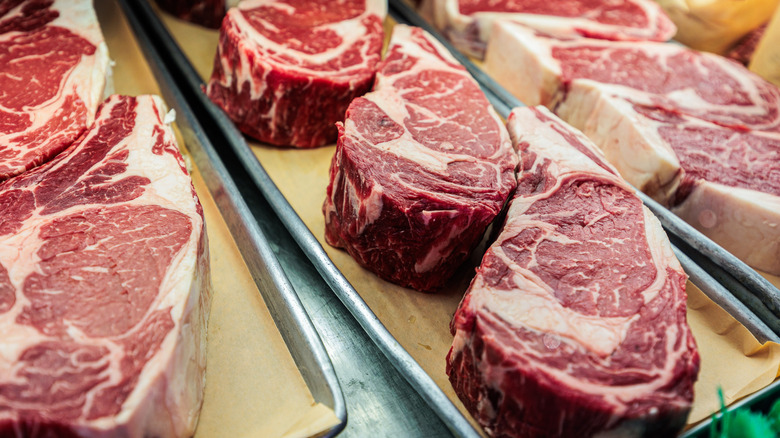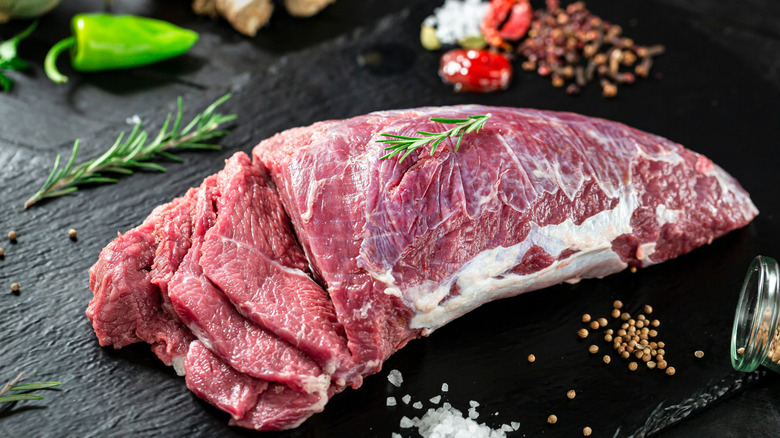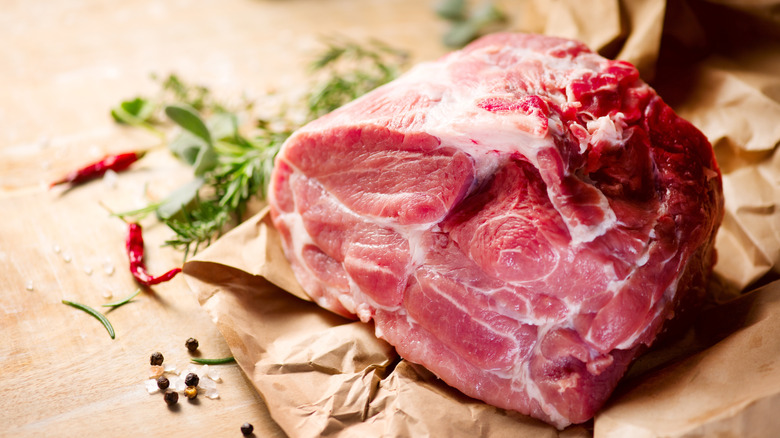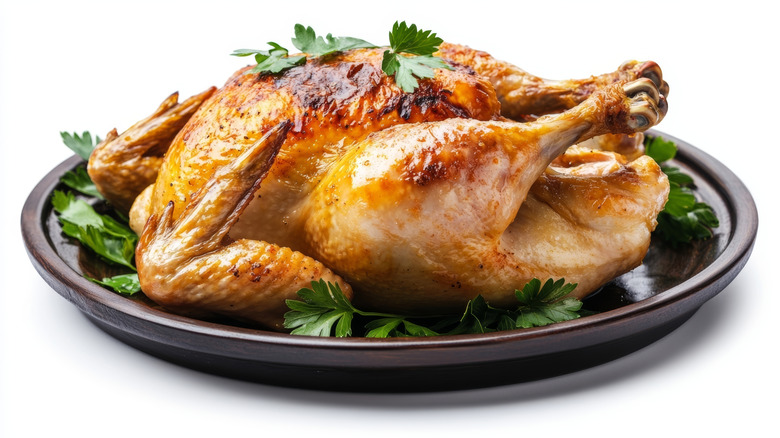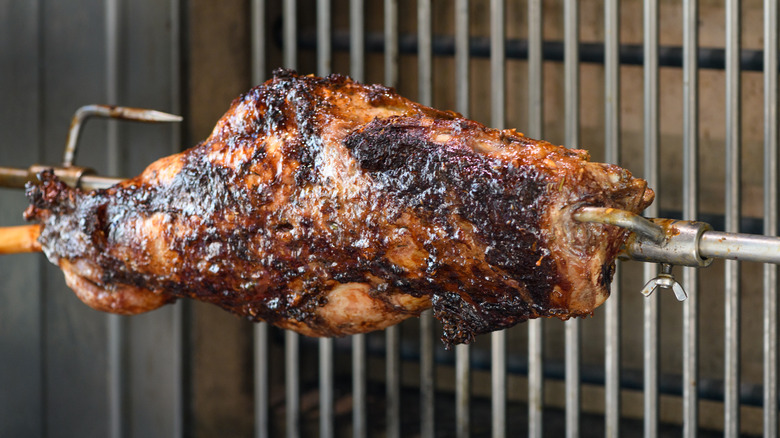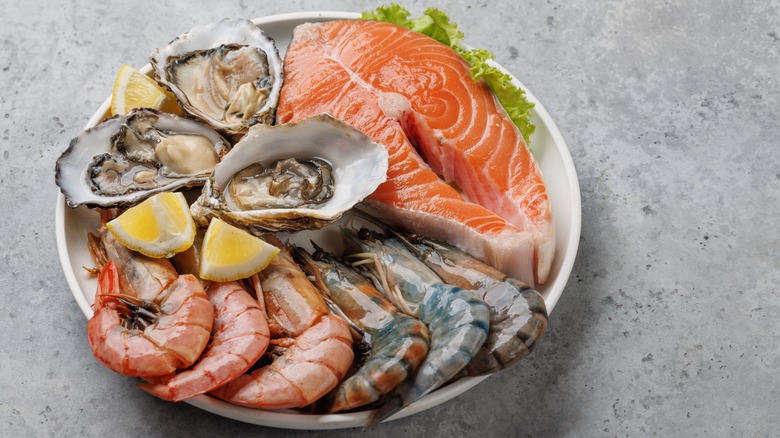6 Meat Products To Buy Now Before Prices Get Out Of Hand
The economy is a delicate thing. It's highly vulnerable to a wide spectrum of disruptive influences like politics, meteorology, disease, supply issues, and even pop culture. No one can predict exactly how the market will turn (or when), but it's still possible to make broad predictions that will guide expectations about certain markets in the near future. The closest things we have to a crystal ball are economic theory and statistical data, so it's easy to find yourself blindsided by sudden price hikes.
A smart budget means planning for the future and avoiding unnecessary expenses. Food is not a luxury, though — it's not something you can simply stop buying just because the economy has taken a turn. And meat is an important source of protein for the human body, which means you may want to know what's in store for the meat market. Here are some broad categories of meat to enjoy now before prices get out of hand.
Beef
Producers of cattle, your beef source, have to decide whether to grow or sell their cows based on the prices said cows fetch on the market. Once the market indicates that it's time to expand the herd size, a cattle producer keeps female calves for breeding instead of putting them up for slaughter. Those calves take about two years to mature before they can give birth, and an additional 18 months before that new cow is ready for slaughter. This kind of herd expansion goes on until, finally, supplies pressure the market to lower beef prices, and that, in turn, leads to herd reduction.
So what does this mean for coming beef prices? Well, cattle inventories peaked in 2019 due to high demand, but projections for 2025 are not so optimistic. According to the USDA, cattle inventories are expected to hit their lowest cow count in decades for the year 2025. Hence, cattle and steer prices are projected to increase for 2026, leading to higher retail prices. That means you'll be shelling out extra for those beef patties. Those prices could remain high for several years until cattle inventories bulk up again.
And that's just the beginning of the problems for beef. In May, the USDA was authorized to issue a suspension on beef imports from Mexico due to an outbreak of screwworm, a brutal pest that feeds on live mammals. These are nasty little insects whose larvae (or let's call them what they are: maggots) burrow into the flesh of warm mammals. This significantly impacts cattle availability, particularly in the Southwest, which compounds the existing problem of lower inventories. And with lower inventories, you can expect those beef prices to get jacked up.
Veal
Veal is a form of beef (and it's also actually used in weiner schnitzel). Specifically, it's beef from a male calf between 16 and 18 weeks of age. The calf is maintained on a diet of milk or milk substitute, and typically lives most of its life in tight quarters. The end result of this controversial process is delicate, supple meat with a pale pink color instead of the darker red color you would expect from normal adult beef. Ethics aside, this is a beef product, and it will be no exception to the coming price hikes for all beef products. Food prices are influenced by a lot of things you might not expect, including weather, interest rates and energy prices.
According to the Consumer Price Index, veal prices jumped up by 0.7% from March 2025 to April 2025. This followed an even bigger increase of 1.6% from February 2025 to March 2025. If you look at veal prices from April of this year, they are a whopping 8.5% higher than those in April 2024. So what does all this mean? We're seeing a trend. Veal prices are climbing. It's predicted that veal prices will see further inflation — about 6.6% — by the end of 2025.
Overall economic inflation rose by 3.3% in January 2025, and this reverberated along the beef market, driving up veal prices. There's also the weather issue of drought. According to the National Integrated Drought Information System, 2024 saw a nationwide record in drought levels. But when drought rears its head, cattle producers have to make some hard decisions. Drought reduces grain supply, which increases demand and hikes up the prices for cattle farmers trying to feed their herd. Those inflated prices are ultimately passed onto the consumer.
Pork
When beef becomes too pricey, some folks turn to pork. Oddly enough, between April 2024 and April 2025, pork production actually rose by 1.3%, per the USDA. But while pork is expected to climb in price slower than beef, the USDA also notes that the rising costs of transportation and processing might bump up pork prices just slightly from where they are currently. This could lead to little price jumps throughout 2025.
That said, the crystal ball is harder to read for answers about impending pork prices. The USDA actually doesn't predict an increase in the cost of pork over the coming year. In fact, they report that pork prices are expected to decrease by 0.2% by the end of 2025. But as with cattle, drought is a growing problem that leads to uncertainty in all livestock trade. There's also the issue of tariffs and their impact on international trade relations. There is currently a 90-day de-escalation of U.S.-Chinese tariffs that affect pork products, but what deal may be reached after those 90 days is anyone's guess.
And even if the tariff does not return to the rate it met prior to the de-escalation, we're still looking at a total tariff rate of 57%. It is very unlikely that this will have a positive impact on the everyday consumer's pork purchasing experience. If China is not buying American hogs at a high volume, that means a decrease in supply due to less demand. And thus the cycle may begin anew, with a temporary pork surplus followed by a dearth. The American pork export market is shifting, and that means uncertainty. With pork prices so heavily affected by trade relations, it is difficult to say what will come of recent economic upheaval.
Poultry
The USDA says that we can look forward to chickens and turkeys flapping right over the fence of reasonable pricing. They're going to increase by a good 2.1% before 2025 is over. That may have something to do with last year's weather patterns, which pushed farmers to remove stock from their normal grazing process and move them onto silage at a pace that was too fast to be ideal. Silage is the moist forage material stored in airtight conditions. It's crucial as a source of food for livestock, but to rely on it so soon would have meant increased costs of maintenance for chicken farmers. That increased cost translates to higher poultry prices. Additionally, last year's harvest yields dropped, meaning less grain as both feed and bedding for chickens.
But that's just looking at recent trends. When you look at the long-term pricing of chicken, it's clear that this is an older problem that is not improving. In fact, chicken is getting more expensive every year. In 1997, the price of a fresh, whole chicken was $1 per pound. Now it's $2.06. That's because, since at least as far back as 1997, chicken has been hit by an annual inflation rate of 2.47%. And prices may continue to grow as time goes on.
At this rate, in another 30 years, chicken will cost $4 per pound, meaning that what you pay for chicken breast right now will be doubled. Let's hope that's not the case, but be ready in case it is. As for turkey, 2024 saw 6 billion pounds of this bird produced nationwide (and no, that's not including lab-grown chicken). This year, it's estimated that there will only be 5.8 billion pounds produced, meaning less supply and more demand — and that means higher turkey prices.
Lamb
If you check the data, you'll notice a major trend in the world of lamb meat prices: They're going up. In fact, after a steep drop in the summer of 2023, lamb prices began to rise, and they haven't stopped. The graph looks like a steep mountain that even an agile goat would be nervous to climb. Trends like this tend to be long-term, and with issues like tariffs and droughts, which affect all livestock, it's looking like lamb is going to keep on climbing in price.
While lamb prices do fluctuate quite a lot by season — for example, they shot up 15% during Easter 2022, which is normal — the chart still shows an overall upward climb from year to year. And as with other livestock, maintenance and feeding factor heavily into the business of sheep care. In 2023, the price of feed for sheep rocketed up 20%. And with all the drought issues of late, this situation doesn't seem to be improving.
Australia is a major source of sheep around the world, and, very recently, sheep processors have been working against problems like scarcity of stock and a powerful demand for mutton exportation. They have lately been forced to pay higher prices for business, and, as always, higher prices along the economic chain of production equal higher prices for consumers. It's impossible to predict what, precisely, will happen to the price of mutton, but it's a solid guess that you'll have to pay more than usual within the year. If you do snag that lamb, here's how to make sure it doesn't dry out in the oven.
Fish and shellfish
Those tariffs are out to get you: especially if you're buying salmon. A new tariff sees the price of Norwegian salmon climbing from $46.75 to $53.76, which means Atlantic salmon will be $7 more expensive than previously. This is because the tariff was placed on Norwegian exports, which are a huge part of the international salmon market. On a related note, everyone who loves shellfish is in for a bit of bad news. According to Global Growth Insight, shellfish farmers have reported challenges in sourcing quality inputs due to issues like disease outbreak. And while shellfish demand seems to be on the rise, the high cost of sustainable aquaculture practices and the installation of regulatory measures may prove to incur unwanted costs that drive up shellfish prices as demand exceeds supply.
As for edible marine life on the whole, weather is a major concern. As with meat economies on land, maritime trade is also affected by weather patterns. According to marine science centers, heatwaves are happening with increasing frequency in Earth's oceans. They're also becoming more intense. This has a disruptive impact on most of the ocean's organisms, and when the sea absorbs this kind of heat, it is stored in the upper ocean where most fish reside.
Because fish are sensitive to temperature shifts of this kind, it causes some species to move further north or into the cooler ocean levels below. Changes of this kind could increasingly lead to disruption in the fishing industry, leading to the development of new strategies or tools to cope with the changes in fish behavior. And increased costs for fisheries means those costs can find their way to consumers. Already, climate issues have led to changes in the distribution and overall abundance of species. If this continues, it could signal a great deal of uncertainty for the fish market.

